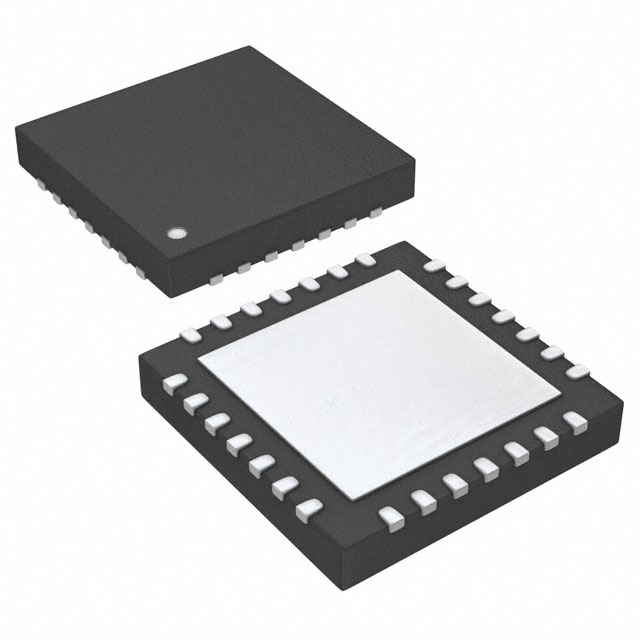PIC16F1718-E/ML
Product Overview
Category
The PIC16F1718-E/ML belongs to the category of microcontrollers.
Use
This microcontroller is commonly used in various electronic applications that require embedded control and processing capabilities.
Characteristics
- High-performance 8-bit RISC architecture
- Flash program memory with self-read/write capability
- Enhanced mid-range core with 49 instructions
- Low power consumption
- Wide operating voltage range
- Multiple communication interfaces (UART, SPI, I2C)
- Analog-to-Digital Converter (ADC) module
- Timers and PWM modules for precise timing control
Package
The PIC16F1718-E/ML is available in a small form factor package known as QFN-28.
Essence
The essence of this microcontroller lies in its ability to provide efficient and reliable control and processing capabilities in a compact package.
Packaging/Quantity
The PIC16F1718-E/ML is typically sold in reels containing a quantity of 250 units per reel.
Specifications
- CPU Speed: Up to 32 MHz
- Program Memory Size: 14 KB
- RAM Size: 1 KB
- Number of I/O Pins: 25
- Operating Voltage Range: 1.8V to 5.5V
- ADC Resolution: 10-bit
- Communication Interfaces: UART, SPI, I2C
- Timers: 3 x 8-bit, 1 x 16-bit
- PWM Channels: 4
- Temperature Range: -40°C to +125°C
Detailed Pin Configuration
The PIC16F1718-E/ML features a total of 28 pins, each serving a specific purpose. The pin configuration is as follows:
- RA0 - Analog Input / Digital I/O
- RA1 - Analog Input / Digital I/O
- RA2 - Analog Input / Digital I/O
- RA3 - Analog Input / Digital I/O
- RA4 - Analog Input / Digital I/O
- RA5 - Analog Input / Digital I/O
- VSS - Ground
- VDD - Power Supply
- RC0 - Digital I/O
- RC1 - Digital I/O
- RC2 - Digital I/O
- RC3 - Digital I/O
- RC4 - Digital I/O
- RC5 - Digital I/O
- RC6 - Digital I/O
- RC7 - Digital I/O
- OSC1/CLKIN - Oscillator Input
- OSC2/CLKOUT - Oscillator Output
- RB0 - Digital I/O
- RB1 - Digital I/O
- RB2 - Digital I/O
- RB3 - Digital I/O
- RB4 - Digital I/O
- RB5 - Digital I/O
- RB6 - Digital I/O
- RB7 - Digital I/O
- MCLR/VPP - Master Clear / Programming Voltage
- VSS - Ground
Functional Features
The PIC16F1718-E/ML offers a range of functional features that make it suitable for various applications:
- High-performance RISC architecture ensures efficient execution of instructions.
- Flash program memory allows for easy reprogramming of the microcontroller.
- Enhanced mid-range core provides a wide range of instructions for versatile programming.
- Low power consumption makes it ideal for battery-powered devices.
- Wide operating voltage range enables compatibility with different power sources.
- Multiple communication interfaces facilitate seamless integration with other devices.
- Analog-to-Digital Converter (ADC) module enables precise measurement of analog signals.
- Timers and PWM modules allow for accurate timing control and generation of analog signals.
Advantages and Disadvantages
Advantages
- High-performance architecture ensures efficient execution of instructions.
- Flash program memory allows for easy reprogramming.
- Low power consumption extends battery life.
- Wide operating voltage range provides flexibility in power supply options.
- Multiple communication interfaces enable seamless integration with other devices.
- Analog-to-Digital Converter (ADC) module allows for precise measurement of analog signals.
- Timers and PWM modules offer accurate timing control and analog signal generation.
Disadvantages
- Limited program memory size may restrict the complexity of applications.
- Limited RAM size may limit the amount of data that can be stored during program execution.
- The small form factor package may require additional care during handling and soldering.
Working Principles
The PIC16F1718-E/ML operates based on the principles of a microcontroller. It executes instructions stored in its program memory to perform specific tasks. The central processing unit (CPU) fetches instructions, decodes them, and executes the corresponding operations. Input/output pins allow the microcontroller to interact with
Senaraikan 10 soalan dan jawapan biasa yang berkaitan dengan aplikasi PIC16F1718-E/ML dalam penyelesaian teknikal
What is the maximum operating frequency of PIC16F1718-E/ML?
- The maximum operating frequency of PIC16F1718-E/ML is 32 MHz.Can PIC16F1718-E/ML be used for motor control applications?
- Yes, PIC16F1718-E/ML can be used for motor control applications with its integrated peripherals and PWM capabilities.Does PIC16F1718-E/ML support communication protocols like I2C and SPI?
- Yes, PIC16F1718-E/ML supports I2C and SPI communication protocols.What are the available memory options for program storage in PIC16F1718-E/ML?
- PIC16F1718-E/ML offers flash program memory options ranging from 14 KB to 28 KB.Can PIC16F1718-E/ML operate at low power?
- Yes, PIC16F1718-E/ML features low-power modes and peripherals to support low-power operation.Is PIC16F1718-E/ML suitable for battery-powered applications?
- Yes, PIC16F1718-E/ML is suitable for battery-powered applications due to its low-power capabilities.What development tools are available for programming PIC16F1718-E/ML?
- Development tools such as MPLAB X IDE and MPLAB Code Configurator support programming and configuration of PIC16F1718-E/ML.Does PIC16F1718-E/ML have analog-to-digital conversion (ADC) capabilities?
- Yes, PIC16F1718-E/ML features on-chip ADC modules for analog signal processing.Can PIC16F1718-E/ML be used in automotive applications?
- Yes, PIC16F1718-E/ML is suitable for automotive applications with its robust design and temperature range.Are there any application notes or reference designs available for PIC16F1718-E/ML?
- Yes, Microchip provides application notes and reference designs to assist in the implementation of PIC16F1718-E/ML in various technical solutions.


